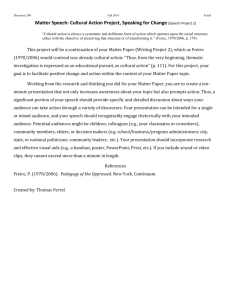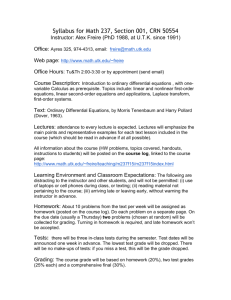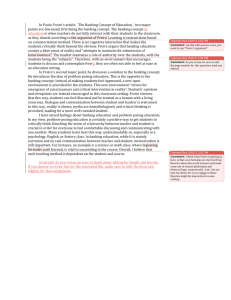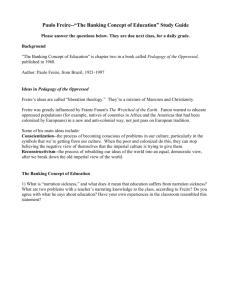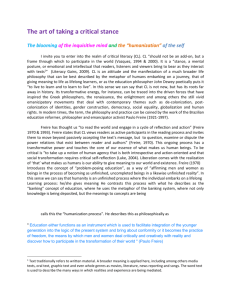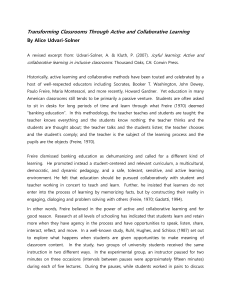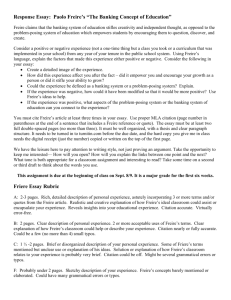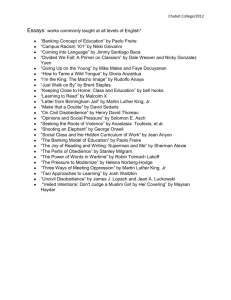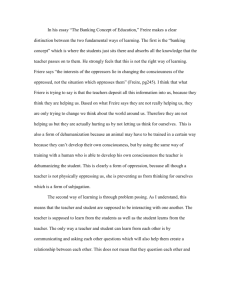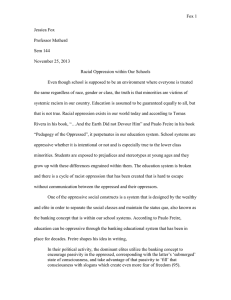Freire
advertisement
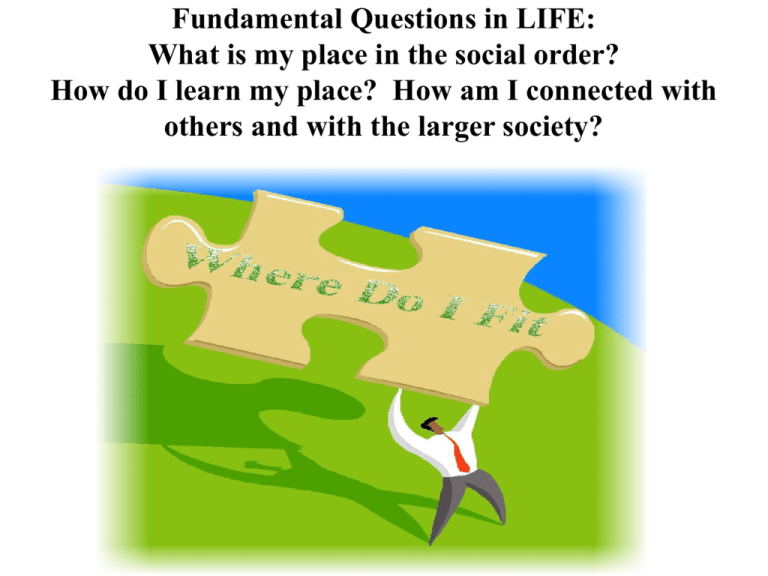
Fundamental Questions in LIFE: What is my place in the social order? How do I learn my place? How am I connected with others and with the larger society? IF THESE WALLS COULD TALK, WHAT WOULD THEY SAY? “The information is up here. Follow along.” http://www.youtube.com/watch?v=dGCJ46vyR9o Write down your reactions to this film. I will call on you. How do these students FEEL about their education? Is it justified? What are their complaints? What are their concerns about their lives? About the world? Video made by a Cultural Anthropology class at Kansas State University Spring 2007 Freire on “Banking” Approaches to Teaching • • • • • • • Teacher teaches, students are taught Teacher knows everything, students know nothing Teacher talks students listen Teacher chooses, students comply Teacher acts, students follow passively Teacher holds authority, students are alienated The lives of the students don’t matter • • Receive, memorize, repeat Views the poor as manageable, they need to adapt to world as is, they get a fragmented view of reality. For FREIRE Knowledge emerges through invention and reinvention in communication with others. Elements: class solidarity, restless, hopeful inquiry, engage in critical thinking and mutual humanization, consciousness of own thinking, reflective about social conditions and change. Through schools and other social experiences in their lives, students learn what? Any student experiencing banking methods of teaching can feel: • Like objects rather than subjects • Alienated • Silenced Are disadvantaged students: • Taught not to question? • Taught to internalize failure, blame themselves (even though school structures can promote failure)?. • Not educated to understand their position in the world? How have Classical Liberal ideas played out in the 20th century? How much have the definitions of liberty and equality changed? Freire offers 20th century critique of education and schooling of the disadvantaged. “Literacy for Liberty” “I have learned to think for myself.” Have all students had this experience? Aim of Education GROWTH AND Paulo Freire began teaching peasants in Brazil who were illiterate, who had no rights and no voice in governing. Eventually, Freire became a city superintendent, and he implemented democratic school reform for the poor. “Every person, regardless of education is capable of looking critically at the world.” Freire Human beings – have equal rights to be free, they are capable, can solve problems, can learn from each other through dialogue, and are creative. Education – to understand and transform the world. The oppressed need ways to obtain greater freedom by working together to change institutions that exclude or mistreat them, they must seek their own emancipation. Key elements of Freire’s approach to learning for the oppressed, disadvantaged, working class student. What kind of citizen does Freire envision this education producing? PROBLEM POSING EDUCATION: • Teachers and students learn together. INQUIRY & DIALOGUE, ACTION (towards change) & REFLECTION about conditions (praxis), and in the process learn skills and content of disciplines. • Non-authoritarian. • Values all kinds of knowledge. • Seeks to connect knowledge with the reality of students’ lives. • Authentic liberation (having voice, autonomy, some power) • Responsible for the process of education (subject, not narrated by others, or simply as objects of banking education) How are efforts to improve conditions for disadvantaged students based on democratic principles? Who is considered a citizen has been expanded since Jefferson’s time. But what about the education of low-income and disadvantaged groups today? Liberal Political Philosopher C.B. McPherson summarizes real equality to mean: FREIRE’S CHALLENGE: ARE MODERN LIBERAL STATES REALLY DEMOCRATIC? Equality before the law. Basic civil liberties for all. Equal rights to self development (one important resource is education). Equal political voice for each citizen (the interests of each member of the community matter equally). FREIRE WOULD APPROVE OF: A low income school looking to engage students with local needs---an example is: Students living near toxic waste dumpsites might investigate the health, environmental, or economic impact on the neighborhood or examine state policies for locating these sites. Or, students living in a low-income neighborhood studying why there are no supermarkets, parks, or after school programs in their area. “The pursuit of humanity cannot be carried out in isolation or individualism, but only in fellowship and solidarity.” Class-based analysis of Freire “No one can be authentically human while he prevents others from being so.” “Some men’s having must not be allowed to constitute an obstacle to other’s having, must not consolidate the power of the former to crush the latter.” (Freire, 1970) In a high tech world, there are efforts to provide technology access to the most disadvantaged students. Pluralist Approach to Curriculum for All Students would bring some understanding of different kinds of experiences, raise social questions, call attention to injustices. What are students learning sitting here? “If these walls could talk, they can’t. But students can, so what do students say?” • • • • • • • • • Large classes-- means what? Reading assigned texts Cost of college Skipping class Relevance of subject matter in classes Books vs. web Writing papers vs. emails Time in the day Multi-tasking • World conditions—over 1 billion people earn less than $1 per day, many experience war, illiteracy, and violence.
